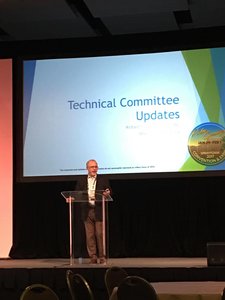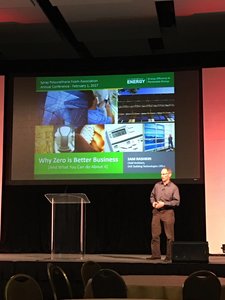General Session Highlights SPFA Committees and DOE's Nero Energy Ready Home initiative
![]() Print this Article | Send to Colleague
Print this Article | Send to Colleague
Rick Duncan kicked off the General Session by giving an update on SPFA's four technical committees: building envelope, roofing, safety and technical oversight. In 2016, the Building Envelope Committee introduced new TechTips like SPF and CPCV, updated TechDocs for SPFA-126 "Thermal and Ignition Barriers for SPF" and SPFA-140 "Spray Polyurethane Foam for Exterior Below-Grade Moisture Protection" and created two new TechDocs: Interior Below-Grade and Below-Slab applications. For the committee's ATSM activities, key areas of interest like ATSM C1029: ccSPF Materials Specification were addressed. The WK41440 was also completed, which is an SPF insulation installation practice and will be published in early 2017. A new Code Compliance Standard for SPF was also established, an alternative for ICC-ES Acceptance Criteria AC-377 and AC-456. Finally, SPF is developing a guidance document on sprayfoam and termites.
For the Roofing Committee in 2016, new TechTips and TechDocs included the revamping of SPFA-127 "Spray Polyurethane Foam Systems Maintenance Manual" and the new SPFA-150 "Photo-Voltaic Systems and SPF Roof Systems." The Roofing Committee was also involved in RICOWI, a group that monitors weather incidents for roofs, and the ORNL Roof Calculator Update. The Safety Committee finished the 2nd year of the SPFA Foam-It-Right Safety Webinar Series, a bi-monthly, one-hour safety webinar series that began in March 2015 and helps members meet the OSHA training and PCP CEU requirements. The committee also began working on construction confined spaces, new requirements announced by OSHA in May 2015 that require confined spaces for attics and crawlspaces.
The Technical Oversight Committee maintained its regular schedule of reviewing all technical documents. After discussing the committees, Duncan recognized Roger Morrison with the Workhorse Award. Duncan finished off by bringing up Jay Johnson and Jay Hutchek to announce the formation of a new committee, an Equipment Committee. Johnson and Hutchek also announced they are looking for help in revising the equipment guidelines.

The final Keynote of the 2017 convention was delivered by Sam Rashkin, chief architect for the Department of Energy Building Technologies Office. Titled "Why Zero is Better Business [And What You Can Do About It]," his presentation gave an overview of the DOE's zero energy home initiative, which is aiming to promote homes that generate minimal energy to drive down utility and other homeowner costs.
"Homeowners are going to know much more in the next three to four years before buying a home," Rashkin said. Rashkin argued the zero home business would result in $250 billion utility bill savings, $70 billion of added construction, 100,000 persistent new jobs, $2.3 million job-years of work and 2,000 MMTOE less air pollution.
The building block of this initiative, said Rashkin, comes from new codes, "Energy efficiency is getting more and more rigorous by virtue of code developments," Raskhin said. "A 38 percent reduction occurred from 2009 to 2012. Everything changes when you build better insulated homes."
In terms of the architecture of zero energy homes, Rashkin presented six systems: optimized enclosure system, water protection system, optimized comfort system, complete in-door air quality system, efficient component system and solar ready system. Since these systems are the qualifying requirements for the updated codes, Rashkin argued that making new homes zero energy is more of a certainty than an uncertainty.
"We chose to use just the word "zero" and remove the word "net" because it protects valuable real estate and ensures simplicity," Rashkin said when discussing the marketing campaign for the zero energy ready home. "We included the word "ready" to protect core customer liability and include consumers." The official slogan is "Zero Energy Ready Home."
When the DOE took a poll of the best researchers and experts, 100 percent chose the zero energy ready home. Rashkin said these experts determine seven must-have areas of readiness: future ready, water ready, comfort ready, tech ready, health ready, zero ready and performance ready.
In terms of ways consumers are becoming more informed, Rashkin cited the more prevalent use of infrared cameras that detect thermal defects, moisture problems and more. "The game changer will be a star rating of homes for homeowners looking for a great home," Rashkin said. "We already use Yelp and Trip Advisor to see what restaurants have four stars or better. When it comes to a person's biggest and likely most emotional purchase of their life, a star rating system would help immensely."
Rashkin finished his presentation by inviting members to becomes partner with DOE, obtain access to the ZERH button, and develop plan and enact a plan. "Sprayfoam products shine in the nation’s best homes if you’re a part of a system," he said.

